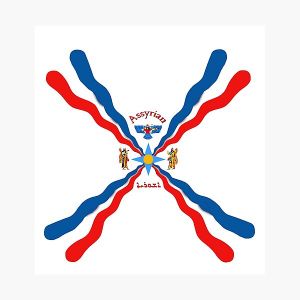Language/Assyrian-neo-aramaic/Grammar/Questions
Hi Assyrian Neo-Aramaic learners! 😊
In this lesson, we will focus on questions in Assyrian Neo-Aramaic. As you know, asking questions is a crucial part of everyday communication. In order to ask questions in Assyrian Neo-Aramaic, it is important to understand some basic grammatical rules that we will cover in this lesson. By the end of this lesson, you will be able to ask and answer various questions in Assyrian Neo-Aramaic. Don't forget to try these questions with your language exchange partners on Polyglot Club. You can also find native speakers and ask them any questions!
Basic questions[edit | edit source]
Asking questions in Assyrian Neo-Aramaic is relatively straightforward. In most cases, a question can be formed by simply putting the auxiliary verb "ܐܘ" (aw) at the beginning of a statement. For example, the statement "ܐܢܫܐ ܣܛܢܐ" (nāšā sāṭnā) means "I drink tea". To turn this into a question, simply add "ܐܘ" (aw) at the beginning: "ܐܘ ܐܢܫܐ ܣܛܢܐ?" (aw nāšā sāṭnā?) which means "Do I drink tea?"
Another way to form a question is by using the question particle "ܢܸܢ" (neen) at the end of a sentence. For example, "ܘܬܝܥܝܢܢܐ ܐܝܟܐ" (weteyʿinna aika) means "You speak Aramaic". To turn this into a question, simply add "ܢܸܢ" (neen) at the end: "ܘܬܝܥܝܢܢܐ ܐܝܟܐ ܢܸܢ?" (weteyʿinna aika neen?) which means "Do you speak Aramaic?"
Here's a table summarizing some basic questions in Assyrian Neo-Aramaic:
| Assyrian Neo-Aramaic | Pronunciation | English |
|---|---|---|
| ܐܘ ܐܢܫܐ ܣܛܢܐ? | aw nāšā sāṭnā? | Do I drink tea? |
| ܘܬܝܥܝܢܢܐ ܐܝܟܐ ܢܸܢ? | weteyʿinna aika neen? | Do you speak Aramaic? |
| ܬܘܠܝܘܬܐ ܕܐܢܫܐܢܐ ܬܝܢܝܐ? | twolyūṯa d’anšānā tēnyā? | What is your name? |
| ܐܝܟܐ ܟܝܕܝ ܡܥܡܐ ܠܟܘܢ? | aika kidi mʿmā lakun? | What time is it? |
Word order in questions[edit | edit source]
In Assyrian Neo-Aramaic, the word order in questions is slightly different than in statements. Generally, the verb comes before the subject in a question, while in a statement, the subject comes before the verb. For example, the statement "ܐܠܐ ܒܪܥܐ ܐܢܐ" (alā brāʿā anā) means "I am not thirsty". To turn this into a question, we put the verb "ܐܪܥ" (arāʿ) before the subject "ܐܢܐ" (anā): "ܐܪܥ ܐܢܐ ܒܪܥܐ?" (arāʿ anā brāʿā?) which means "Am I not thirsty?"
Here are some other examples of word order in questions:
| Assyrian Neo-Aramaic | Pronunciation | English |
|---|---|---|
| ܐܘ ܐܢܫܐ ܬܠܡܝܢܐ? | aw nāšā tlāmyāna? | Do I need help? |
| ܬܝܢܝܐ ܐܝܟܐ ܕܐܬܪܝܘܬܐ? | tēnyā aika detaryūṯā? | What is your job? |
Question words[edit | edit source]
Question words are an important part of asking questions. In Assyrian Neo-Aramaic, most question words begin with the letter "ܕ" (d). Here are some important question words and their meanings:
| Assyrian Neo-Aramaic | Pronunciation | English |
|---|---|---|
| ܕܐܢܫܐܢܐ | d’anšānā | Who? |
| ܕܦܐܬܐ | dfātā | Where? |
| ܕܝܢ | dyn | When? |
| ܕܪܘܚܐ | drūḥā | Why? |
| ܕܘܠܐ | dwlā | How? |
Here are some examples of questions using question words:
- Person 1: ܕܒܢܫܐܢܐ ܚܕܠܐ ܕܝܢ? (d’bnšānā ḥdāla dyn?) - (Who won the game?)
- Person 2: ܐܠܝܕܝ ܩܕܡܝܐ ܒܝܬ ܕܪܘܚܐ. (alīdi qadmiya bēt drūḥā.) - (Because of their strategy.)
Dialogue[edit | edit source]
Here's a dialogue to illustrate how to use questions in Assyrian Neo-Aramaic:
- Person 1: ܐܝܟܐ ܟܝܕܝ ܡܥܡܐ ܠܟܘܢ? (aika kidi mʿmā lakun?) - (What time is it?)
- Person 2: ܩܡ ܒ ܬܫܥܬܐ ܕܒܝܬ ܪܝܫܐ. (qam b-tšʿta d-beet rēšā.) - (It's eight in the morning.)
- Person 1: ܕܐܢܫܐܢܐ ܕܝܢ ܐܝܟܐ ܕܩܕܡܝܐ? (d’anšānā dyn aika d-qadmiya?) - (When did you arrive?)
- Person 2: ܦܐܬܐ ܕܕܘܬܝܐ ܠܗܘܢ ܕܬܫܥܬܐ. (pfātā d-dōtyā lahwōn d-tšʿta.) - (Yesterday in the evening.)
Conclusion[edit | edit source]
In this lesson, we covered the basic rules of how to form questions in Assyrian Neo-Aramaic. We learned that questions can be formed by adding the auxiliary verb "ܐܘ" (aw) at the beginning of a sentence, or by using the question particle "ܢܸܢ" (neen) at the end of a sentence. We also learned that the word order in questions is slightly different from statements, and we covered some common question words. Remember to practice asking and answering questions with your language exchange partners, and try to use the examples we covered in this lesson. Keep up the good work! 😊
➡ If you have any questions, please ask them in the comments section below.
➡ Feel free to edit this wiki page if you think it can be improved. 😎
Sources[edit | edit source]
Having concluded this lesson, consider checking out these related pages: Say Hello and Greetings in Assyrian Neo-Aramaic, Plurals & Adjectives.

